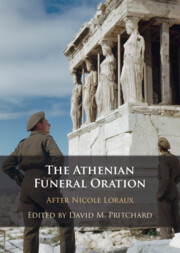Book contents
- The Athenian Funeral Oration
- The Athenian Funeral Oration
- Copyright page
- Contents
- Figures and Tables
- Contributors
- Foreword
- Preface
- Abbreviations
- 1 The Funeral Oration after Loraux
- Part I Contexts
- 2 The ‘Beautiful Death’ from Homer to Democratic Athens
- 3 Between Ideology and the Imaginary: The Invention of The Invention of Athens
- 4 An Imaginary with Images: Reconsidering the Funeral Oration and Material Culture
- Part II The Historical Speeches
- Part III The Literary Examples
- Part IV Intertextuality
- Part V The Language of Democracy
- References
- General Index
- Index of Sources
4 - An Imaginary with Images: Reconsidering the Funeral Oration and Material Culture
from Part I - Contexts
Published online by Cambridge University Press: 11 January 2024
- The Athenian Funeral Oration
- The Athenian Funeral Oration
- Copyright page
- Contents
- Figures and Tables
- Contributors
- Foreword
- Preface
- Abbreviations
- 1 The Funeral Oration after Loraux
- Part I Contexts
- 2 The ‘Beautiful Death’ from Homer to Democratic Athens
- 3 Between Ideology and the Imaginary: The Invention of The Invention of Athens
- 4 An Imaginary with Images: Reconsidering the Funeral Oration and Material Culture
- Part II The Historical Speeches
- Part III The Literary Examples
- Part IV Intertextuality
- Part V The Language of Democracy
- References
- General Index
- Index of Sources
Summary
Nicole Loraux’s understanding of ideology as a system of representations and her analysis of the beauty of the dead would all seem to offer an opening for the incorporation of material culture into an analysis of the funeral oration. In spite of this, images had almost no function in her The Invention of Athens. For Loraux, the denial of an oracular spectacle of the body offered a contrast with Homeric valuations of death. She charted a move from the beautiful dead to the beautiful death that entailed a shift from aesthetics to morals. Loraux denied any role for visual culture in the funeral oration because, she argued, hearing had replaced sight. While Loraux’s analysis emerged from iconographic and structuralist approaches that implicitly contrasted abstraction and figuration, a conception of material culture that incorporates materiality and phenomenology offers important new perspectives. The funeral oration was only one component of a ritual that moved through spaces that were laden with objects and images articulating, manipulating, appropriating and, at times, rejecting the funeral oration’s beautiful death. Considering this wider material frame allows us to nuance some of Loraux’s central arguments.
Keywords
- Type
- Chapter
- Information
- The Athenian Funeral OrationAfter Nicole Loraux, pp. 89 - 112Publisher: Cambridge University PressPrint publication year: 2024

